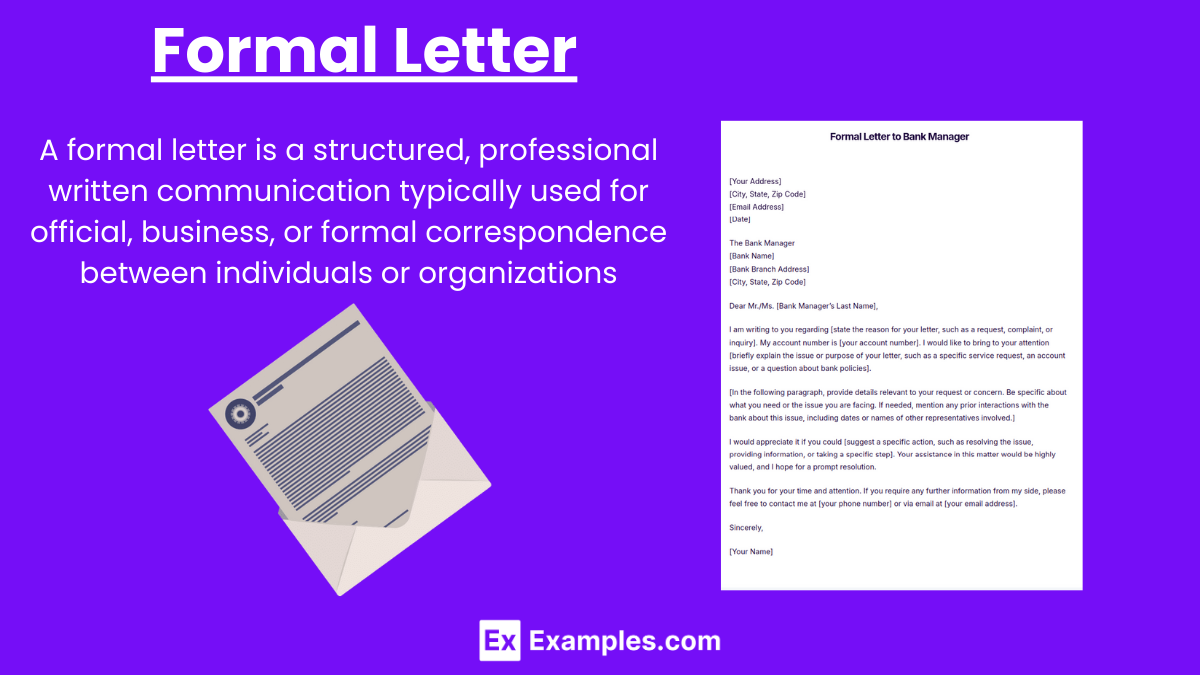10+ Formal Letter Examples to Download
In the presence of formal email writing, letter writing has become less common. However, some letters that are written such as writing a letter for a job application, request for proposal, bank applications, remain important. A formal letter writing example follows the correct format that is used in every business application.
What Is a Formal Letter?
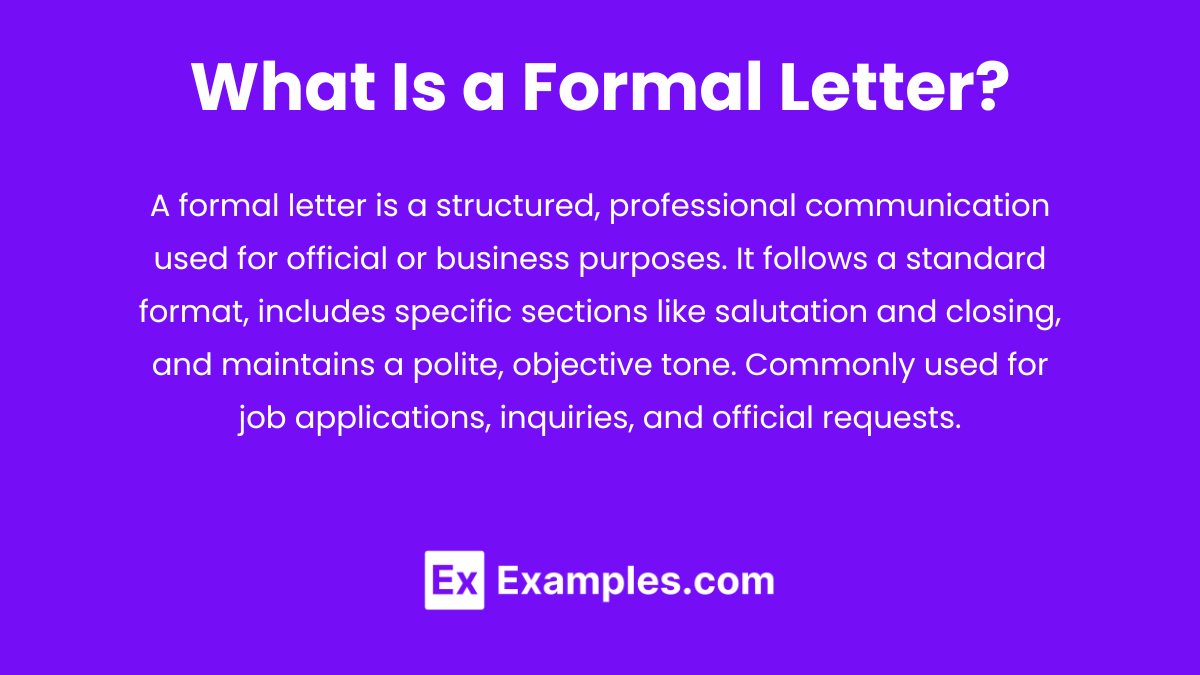
Formal Letter Examples Bundle

Download Formal Letter Examples Bundle
Formal Letter Format
Your Name
[Your Address]
[City, State, Zip Code]
[Email Address]
[Date]
Recipient’s Name
[Recipient’s Position/Title]
[Company/Organization Name]
[Company/Organization Address]
[City, State, Zip Code]
Subject
[Brief Subject of the Letter]
Dear
[Recipient’s Name/Title]
Opening Paragraph
Start with a polite greeting and state the purpose of your letter clearly. Mention the reason for your communication right away to establish the context.
Body Paragraph
Expand on the purpose of the letter. Include relevant details, facts, or explanations to support your main point. Use concise, professional language and maintain a polite tone. If there are multiple points, break them into separate paragraphs for clarity.
Closing Paragraph
Summarize your message or request. Mention any follow-up actions, like expecting a response or indicating you are available for further discussion. Thank the recipient for their time and consideration.
Sincerely
[Your Name]
[Your Position/Title, if applicable]
[Contact Information, if necessary]
Formal Letter Example
John Smith
123 Maple Street
Springfield, IL 62704
john.smith@email.com
October 16, 2024Mr. Robert Johnson
Customer Service Manager
ABC Corporation
456 Elm Avenue
Chicago, IL 60601Subject: Inquiry Regarding Product Availability and Pricing
Dear Mr. Johnson,
I am writing to inquire about the availability and pricing of your company’s latest line of office furniture. We are considering a bulk purchase for our new office location and would appreciate detailed information regarding your products, including any volume discounts or promotional offers available.
Specifically, we are interested in ergonomic chairs and modular desks that would suit a modern, open-office layout. Additionally, we would like to know about shipping options, lead times, and warranties for these products.
Please let us know if there are catalogs, brochures, or a website we can refer to for further details. You may reach me at the above email address or by phone at (555) 123-4567. I look forward to your response.
Thank you for your attention to this matter.
Sincerely,
John Smith
Purchasing Coordinator
Short Formal Letter Example
Emma Brown
456 Pine Road
Houston, TX 77002
emma.brown@email.com
October 16, 2024Mr. James Lee
Human Resources Manager
XYZ Corporation
789 Oak Street
Houston, TX 77002Subject: Request for Leave on October 23, 2024
Dear Mr. Lee,
I am writing to formally request a day off on October 23, 2024, due to a personal commitment. I have ensured that all my responsibilities will be covered in my absence, and I will be reachable via email if needed.
Thank you for considering my request. Please let me know if you need any additional information.
Sincerely,
Emma Brown
Formal Letter to Principal
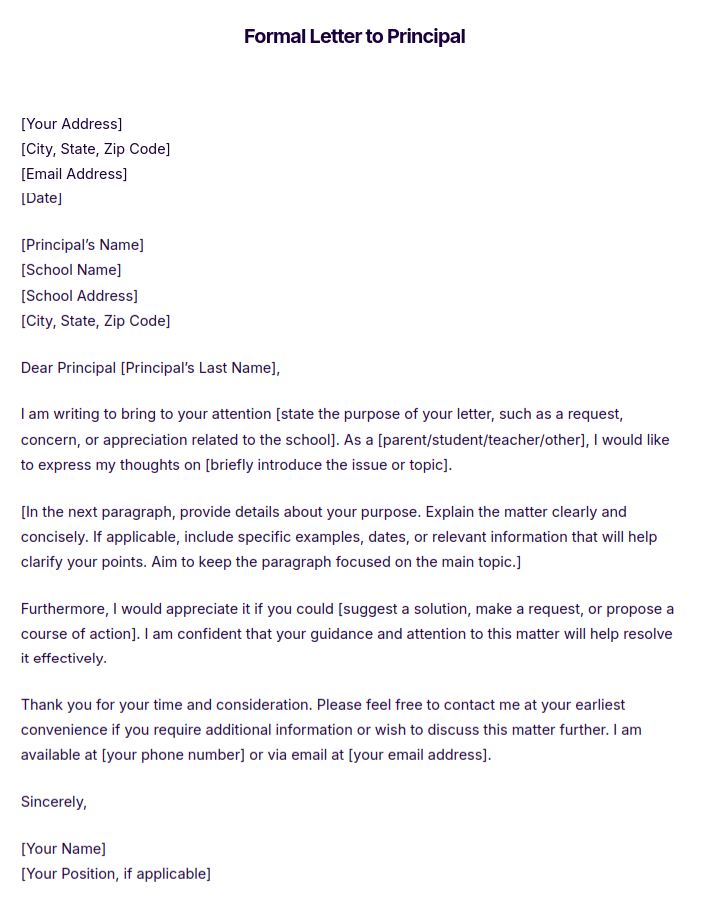
Formal Letter To Teacher
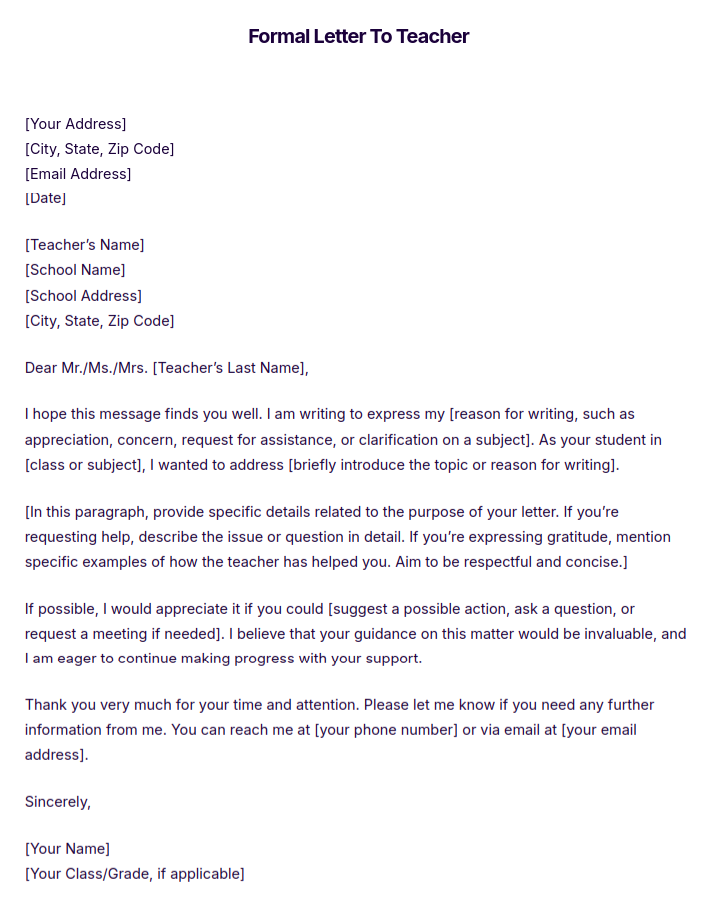
Formal Letter to Bank Manager
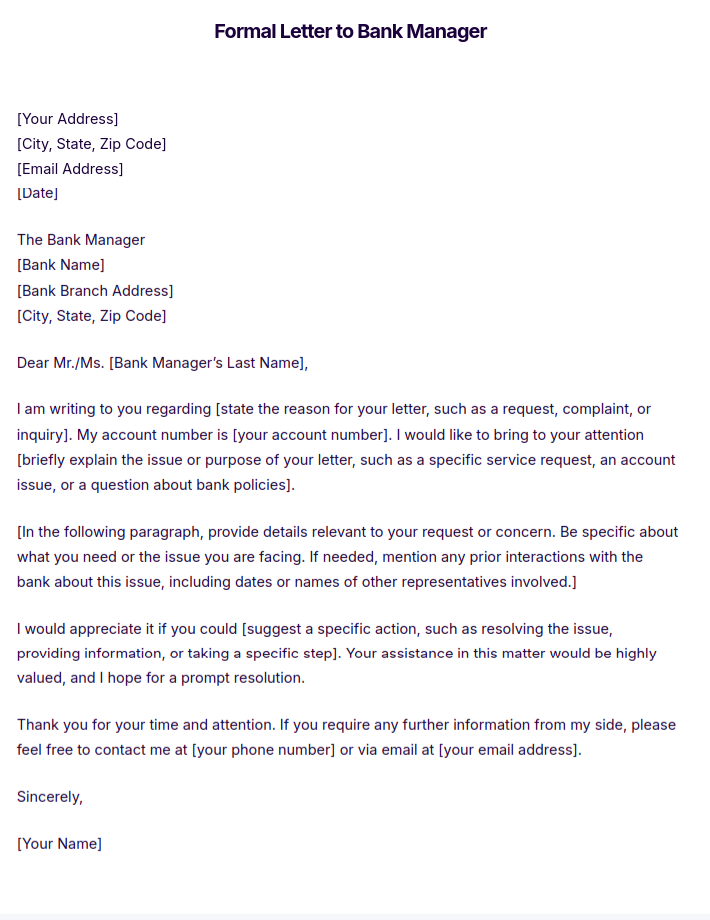
10+ Formal Letter Examples & Samples
Free Formal Letter Format
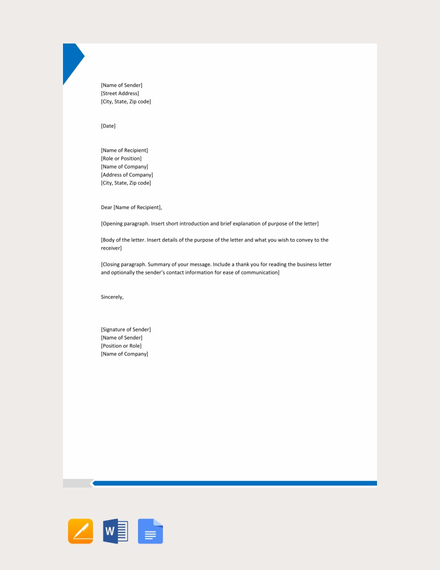
Free Formal Letter Example
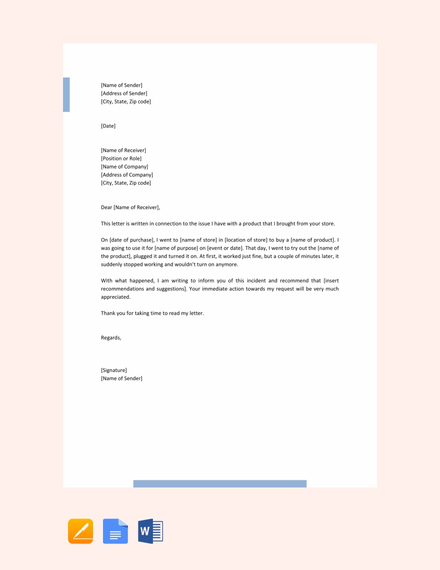
Free Formal Thank You Letter Template
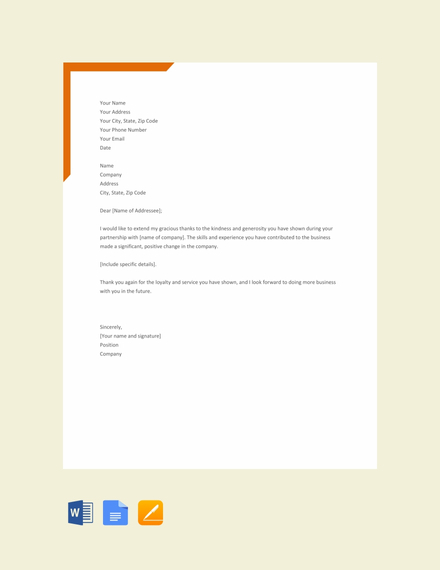
Formal Leave Letter Template
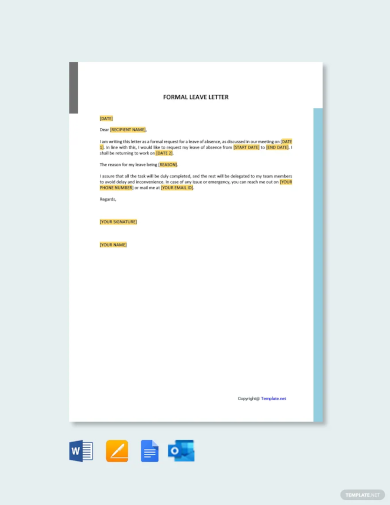
Formal Apology Letter To Boss Template
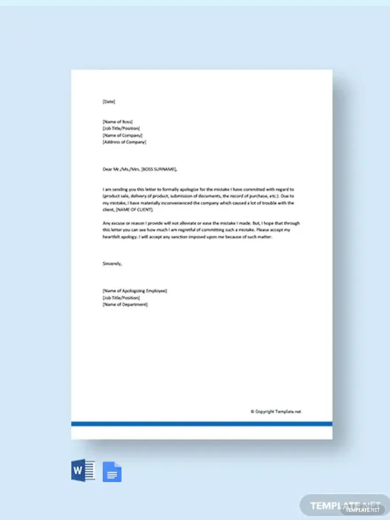
Formal Interview Letter Template
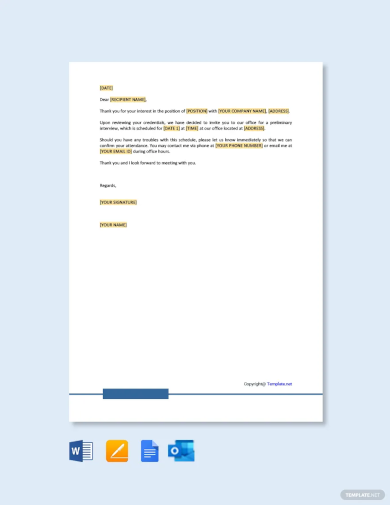
How to Make a Formal Letter
When you think of doing formal letter writing, the very first thing you are going to be asking yourself is how formal do you need it to be? There are of course the do’s and the don’ts when making the letter. Here are guidelines to help you create your formal letter.
Step 1: Always Provide Your Name and Address as the Sender
Important thing to notice is to always provide your complete details. This includes your complete name, your complete address and your complete contact details to the sender. This piece of information is necessary for any formal letter you are writing.
Step 2: Avoid Using Unfamiliar Slang, Jargon, and Complex Language
Never use unfamiliar slang, jargon, or complex languages. This can lead to unnecessary arguments or misinterpreted information on both ends. In order for your letter to come across as professional and formal, avoid using slang and jargon. Use basic or general words.
Step 3: Make Your Message Clear and Concise
When writing formal letters, always make sure that you are making your messages clear and concise. Avoid having to go around in circles, which is going to make your messages unclear and difficult to comprehend. Get straight to the point in a formal and professional manner.
Step 4: Proofread to Avoid Any Wrong Grammar, Spellings, and Punctuation – Make this bold
Lastly, always remember to proofread your work. Before sending the letter, check for any grammar mistakes, spelling mistakes, and punctuation mistakes. Your letter would look unprofessional if the receiver would see a lot of grammar mistakes and misspelled words.
Tips For Writing Formal Letter
- Use a Professional Format
Include your address, the date, the recipient’s address, a salutation, the body, a closing statement, and your signature. This structure ensures your letter looks organized and professional. - Be Clear and Concise
State your purpose early in the letter, and keep your sentences brief. Avoid adding unnecessary details so the recipient can quickly understand your message. - Maintain a Formal Tone
Use polite, respectful language and avoid slang or casual expressions. Address the recipient with their title and last name (e.g., “Dear Ms. Green”) and use a formal closing, such as “Sincerely” or “Respectfully.” - Proofread Carefully
Check for grammar, spelling, and punctuation errors to ensure your letter is polished and error-free. Reading the letter aloud can help catch mistakes and improve clarity. - Include Contact Information and Make a Copy
Provide your phone number or email for easy follow-up. Keep a copy of the letter for your records in case you need to refer to it later.
FAQs
What is a formal letter?
A formal letter is a written communication following a specific format, used for professional or official purposes, such as business inquiries, job applications, or formal requests.
How should I structure a formal letter?
A formal letter typically includes your address, the date, the recipient’s address, a formal salutation, the body of the letter, a closing statement, and your signature.
What tone should a formal letter have?
Use a respectful, professional, and polite tone. Avoid slang or casual language, and keep your sentences clear and concise.
How do I properly address the recipient?
Start with “Dear” followed by the recipient’s title and last name (e.g., “Dear Mr. Smith”). If you don’t know their name, you can use a general greeting like “To Whom It May Concern.”
What is the best way to close a formal letter?
End with a polite closing phrase like “Sincerely” or “Yours faithfully,” followed by your full name and, if relevant, your job title.


